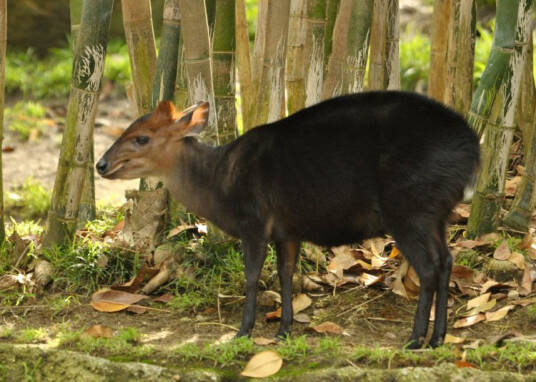Cephalophus niger
IUCN
LCBasic Information
Scientific classification
- name:Cephalophus niger
- Scientific Name:Cephalophus niger
- Outline:Ungulata
- Family:Artiodactylus Bovidae Gazella
Vital signs
- length:90-100cm
- Weight:17-26kg
- lifetime:About 14 years
Feature
Black in color, with a usually red face and a tuft of bright red hair on the forehead
Distribution and Habitat
Distributed in Côte d'Ivoire, Ghana, Guinea, Liberia, Nigeria, Sierra Leone and Togo.
The black duiker is endemic to the Upper Guinea Forest and is a terrestrial animal that is distributed vertically from sea level to an altitude of 1,000 meters above sea level. It is distributed in several different areas of the forest. They live in rainforests and other forested areas and can also be found on the edges of these forests, and even in scrub and degraded forests. It is widely distributed throughout its range and is able to adapt to growing in secondary forests, which makes it less susceptible to habitat loss than other species in the Upper Guinea Forest.
Appearance
The black duiker is 90-100 cm long, 45-50 cm tall at the shoulder, and has a tail length of 9-4 cm; adults weigh 17-26 kg. Females tend to be slightly larger than males, but the sexes are otherwise similar. The coat is soft and black in color. The underparts are slightly paler than the back, except for the underside of the tail, which is bright white. The neck becomes increasingly gray near the head, so that the throat and chin are light gray. The face is usually red, with a tuft of bright red hair on the forehead. Both sexes have straight, pointed horns that slope back from the forehead, which are usually 7-9 cm long in males and much shorter in females, at only 2.3 cm.
Details
Black Duiker (scientific name: Cephalophus niger) is called Black Duiker in English, Céphalophe noir in French, and Schwarzducker in German. There is no subspecies.

The Tanzanian Duiker and the Black Duiker are both dark in color, but the Tanzanian Duiker has a bright reddish-brown crest on its forehead, is much larger than the Black Duiker, and is confined to the mountainous regions of Tanzania.
The duiker generally lives alone or in pairs. The species is a sedentary and territorial animal. Some consider them diurnal, while others consider them nocturnal and crepuscular. Its territory is generally about 0.1 hectare in size. It is most active at dawn and dusk; in undisturbed areas, it may be more diurnal, while increased human activity may lead to a shift to a more nocturnal lifestyle. Resting spots are usually chosen in dense bushes or between the trunks and exposed roots of large trees.
The duiker eats a variety of foods, with fruits and leaves being the most common. Food eaten includes: flowers, leaves, buds, twigs, grasses, herbs, berries, fruits, termites, ants, snails and bird eggs.
The black duiker does not appear to have a restricted breeding season. Although in Ghana the peak births occur in November, December and January, they breed all year round. Gestation period is about 7 months. Only one calf is born per litter; the offspring weighs about 1 kg. Weaning takes no longer than 5 months. Males grow faster than females, but both sexes double their weight in the first month. Females reach sexual maturity between 9-12 months. Males reach sexual maturity between 12-18 months. Lifespan is up to 14 years.
In 1999, assuming an average density of 2 duikers per square kilometer, with a known common abundance of 0.2 per square kilometer elsewhere, the total population was estimated to be about 100,000. Population trends are likely to be gradually decreasing over a large part of the range. The species is particularly common and successful in the central region from Liberia to Ghana, but is rare or declining east and west of this heartland. It was once common in Sierra Leone, but by 1990 had been reduced to isolated areas.
The black duiker's adaptability to degraded secondary forest and farmland scrub has allowed it to withstand the advance of settlement better than other medium-sized forest antelope species in West Africa, and it remains widespread throughout its historic range. Although a common component of bushmeat, it has shown resistance to hunting and remains locally common. Given this, its numbers are likely to persist for considerably longer than most other medium- and large-sized antelope species in West Africa. Nonetheless, it has disappeared from areas of the mountain range (1999) where the species was previously more densely populated.
Listed in the IUCN Red List of Threatened Species in 2016 ver3.1 - Least Concern (LC).
Protect wild animals and eliminate game.
Maintaining ecological balance is everyone's responsibility!








